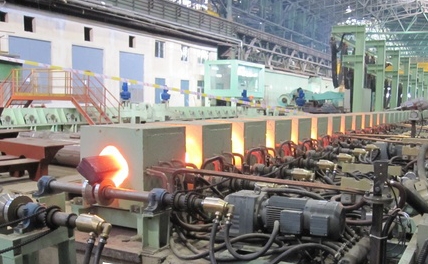- 26
- Jan
Phân tích lợi ích của thiết bị gia nhiệt phôi đúc liên tục
Phân tích lợi ích của thiết bị gia nhiệt phôi đúc liên tục:
Sử dụng quy trình cán trực tiếp (lấy sản lượng hàng năm 1 triệu tấn làm ví dụ), các lợi ích khác nhau được tạo ra:
1. Tiêu thụ năng lượng và giảm phát thải của lò sưởi
For ordinary billet and wire rod mills, the energy consumption per ton of steel production is about 650kWh, of which about 520kWh is used to heat the billet to 1150°C, while the energy consumption for rolling is only 110kWh. However, the actual physical heat per ton of billet at this temperature is only 230kWh, and various heat losses such as the thermal efficiency of the heating furnace exceed 50%. Therefore, direct rolling without heating can save fuel and reduce energy consumption.
For continuous casting billet heating equipment that uses coal as fuel, even in the case of continuous casting billet hot delivery, the average coal consumption of the heating furnace is 45kg/t steel. The elimination of the heating furnace process can save about 45,000 tons of standard coal each year, which translates to a reduction of 117,000 tons of carbon emissions, 382.5 tons of sulfur dioxide, and 333 tons of nitrogen oxides.
Đơn giá than là 1,000 nhân dân tệ / tấn, và việc loại bỏ gia nhiệt và sử dụng cán trực tiếp có thể tiết kiệm 45 nhân dân tệ cho mỗi tấn thép, có thể tiết kiệm 45 triệu nhân dân tệ mỗi năm.
For the heating furnace using blast furnace gas as fuel, even in the case of continuous casting billet hot delivery, the average gas consumption of the heating furnace is 250m3/t steel. The heating furnace process is cancelled and the blast furnace gas is used for power generation. According to the 3.5m3 blast furnace gas, 1 kilowatt-hour of electricity can be generated, and a ton of steel can be converted to 71.4kwh. According to the calculation of the power generation benefit of 0.5 yuan/kwh after deducting the self-consumption and consumption, the annual benefit of additional power generation is 35.71 million yuan.
2. Giảm mất quá trình cháy do quá trình oxy hóa
The use of direct rolling avoids the secondary heating of the billet and can reduce the oxidation burning loss by at least 0.6%. The unit price is 2,000 yuan/t, which can save 12 million yuan per year.
3. Cắt lửa đúc liên tục và giảm đường cắt
Cán trực tiếp được sử dụng và phôi đúc liên tục được thay đổi từ máy cắt mỏ hàn sang máy cắt thủy lực. Chi phí tiêu thụ khí đốt của máy cắt mỏ hàn là khoảng 0.5 nhân dân tệ / tấn, và cứ 12m khe phôi là 5mm, mức tiêu thụ thép tương đương là 0.47kg / tấn. Theo tính toán 1 triệu tấn tương đương với 1.44 triệu nhân dân tệ giảm chi phí cắt khí đốt hàng năm.
4. Bảo trì lò sưởi và giảm nhân công
An annual output of 1 million tons of push-steel heating furnace is equivalent to an average annual maintenance cost of 750,000 yuan, labor costs 1 million yuan, and heating furnace mechanical power consumption costs 1.5 million. After the total cancellation of the heating furnace, the maintenance and labor costs can be reduced by 3.25 million.
To sum up the benefits of continuous casting billet rolling equipment, for the common steel-making and rolling production line with an annual output of 1 million tons using blast furnace gas as fuel and hot charging and hot delivery of continuous casting billets, after the heating furnace is eliminated, the continuous casting and rolling process can be used. It brings an annual benefit of 52.4 million yuan, and according to the operating data, the electricity consumption of the newly added continuous casting and rolling equipment is roughly equal to that of the original cooling bed, hot feed roller table, and traveling crane. The low temperature of the straight-rolled billet will increase the power consumption of rolling by about 10kwh/t steel, resulting in an additional annual power consumption of about 6 million. After deduction, the overall economic benefit is still 46.4 million yuan, which is very impressive.

